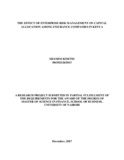| dc.description.abstract | The objective of the study was to determine the effect of ERM on capital allocation among insurance firms in Kenya. Insurance companies offer protection to policyholders in return for a premium payment. They are required to pay the claims as they fall due and therefore, capital must be held by the companies’ in order to fulfill the promise under all circumstances. Companies should accurately assess the amount of capital that is adequate to keep a business solvent. Recently, a risk based capital regime has been introduced in Kenya. The model encompasses all risks a company faces and ensures that they maintain sufficient capital to meet their obligations. Ideally, an insurance company should hold capital commensurate to its size and risk profile. Therefore, ERM is very crucial in the capital allocation process. Prior studies conducted have not examined the relationship between these two variables. The population of the study includes all insurance companies, however, a sample of 34 companies was examined. Secondary Data was collected from Insurance Regulatory Authority and Insurance companies financial reports. A regression analysis was used in the data analysis. The results revealed that underwriting profits /loss, market risk exposure, credit risk exposure, revenue and net liquid assets significantly affect the allocation of capital among insurance companies. The regression equation revealed that underwriting profits /loss, market risk exposure, credit risk exposure and revenue had a positive relationship with capital allocation of insurance companies. The study also found that there was a negative relationship between net liquid assets and capital allocation of insurance companies. The study emphasized the need for companies to manage the related risks through ERM in order to reduce the required capital. The study also revealed that revenue, net liquid assets and market risk exposure were all significant variables. Revenue, an indicator of operational risk, was the most significant variable and therefore operational risk management would yield the significant results in terms of reducing the capital to be allocated to an insurance business. | en_US |



